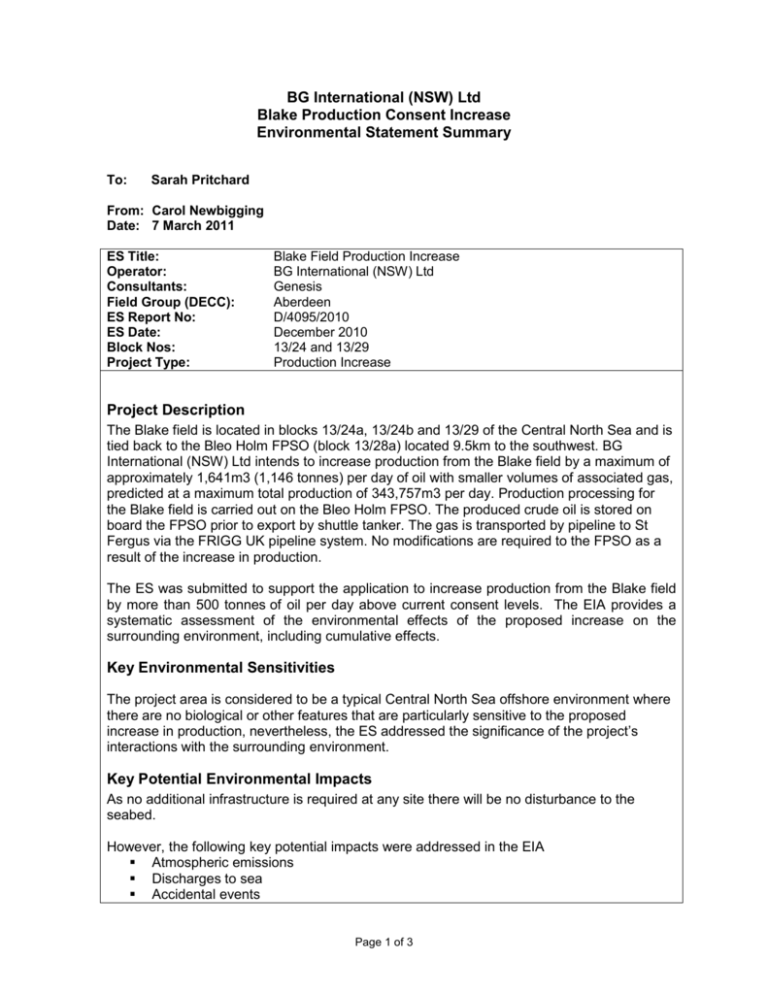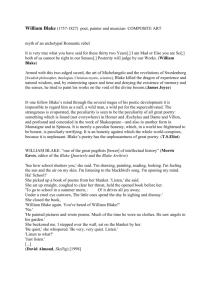Blake Production Consent Increase
advertisement

BG International (NSW) Ltd Blake Production Consent Increase Environmental Statement Summary To: Sarah Pritchard From: Carol Newbigging Date: 7 March 2011 ES Title: Operator: Consultants: Field Group (DECC): ES Report No: ES Date: Block Nos: Project Type: Blake Field Production Increase BG International (NSW) Ltd Genesis Aberdeen D/4095/2010 December 2010 13/24 and 13/29 Production Increase Project Description The Blake field is located in blocks 13/24a, 13/24b and 13/29 of the Central North Sea and is tied back to the Bleo Holm FPSO (block 13/28a) located 9.5km to the southwest. BG International (NSW) Ltd intends to increase production from the Blake field by a maximum of approximately 1,641m3 (1,146 tonnes) per day of oil with smaller volumes of associated gas, predicted at a maximum total production of 343,757m3 per day. Production processing for the Blake field is carried out on the Bleo Holm FPSO. The produced crude oil is stored on board the FPSO prior to export by shuttle tanker. The gas is transported by pipeline to St Fergus via the FRIGG UK pipeline system. No modifications are required to the FPSO as a result of the increase in production. The ES was submitted to support the application to increase production from the Blake field by more than 500 tonnes of oil per day above current consent levels. The EIA provides a systematic assessment of the environmental effects of the proposed increase on the surrounding environment, including cumulative effects. Key Environmental Sensitivities The project area is considered to be a typical Central North Sea offshore environment where there are no biological or other features that are particularly sensitive to the proposed increase in production, nevertheless, the ES addressed the significance of the project’s interactions with the surrounding environment. Key Potential Environmental Impacts As no additional infrastructure is required at any site there will be no disturbance to the seabed. However, the following key potential impacts were addressed in the EIA Atmospheric emissions Discharges to sea Accidental events Page 1 of 3 Atmospheric emissions Total emissions associated with the Blake field production increase are anticipated to be equivalent to a maximum of 0.2% and 0.5% of the total UKCS 2009 offshore emissions of CO2 and NOx respectively. Based on P10 production profiles and EEMS 2009 returns, the Blake field production increase is anticipated to make minor contributions to the UK total offshore emissions from oil and gas installations. All emissions will vary proportionately with hydrocarbon production, however, the maximum contributions to UK offshore emissions associated with the production increase are anticipated to be minor. Furthermore, impacts associated with production from years 2015 to end of field life in 2020 are anticipated to be insignificant as they are predicted to be less than those that were present in 2009. With the distance from the mainland and the strong dispersive regime of the area along with the decline in production over field life, it is not anticipated that atmospheric emissions associated with the Blake field production increase will have detrimental impacts on the local environment. Produced water (PW) emissions Produced water associated with the production increase is anticipated to be a maximum of 3,006m3 per day which accounts for approximately 0.23% of the total produced water discharged in the UKCS in 2008. Based on peak production rates and a discharge quality, in line with regulatory requirements, of 30mg/l oil in water content, a maximum of 0.09 tonnes per day of oil will be discharged to the sea as a result of the production increase. Therefore, the maximum oil discharged to sea per year during the production increase (until 2015) is anticipated to be equivalent to a maximum of 0.4% of the UKCS dispersed oil discharged during 2008. Thus, it is anticipated that the Blake field will make minimal contributions to the UKCS produced water and dispersed oil in water discharge levels. The discharges from the installation currently meet the <30 mg/l dispersed oil in water regulatory requirement. Accidental events As the host installation operator differs from the Blake field operator, both Talisman and BG have responsibilities to minimise the occurrence of accidental events leading to the release of hydrocarbons into the marine environment. Two OPEPs are currently in place, BG’s OPEP for the Blake field, which covers the field and the export pipelines, and Talisman’s OPEP for the Ross field, which covers the Bleo Holm FPSO. Both OPEPs currently meet the conditions of the OPRC Regulations and the EPC Regulations. Page 2 of 3 Public Consultation: No comments were received as a result of the public consultation. Consultee(s): The statutory consultees for this project were JNCC and Marine Scotland (MS). The following comments were received: JNCC -: JNCC commented that they considered the proposed production increase was unlikely to have a significant effect on the nature conservation value of the marine environment. Marine Scotland -: MS commented that the site specific section in Section 3.5.2 Benthos would benefit from a little expansion to give some idea of the variability and distribution of the obviously highly diverse and abundant fauna found at the location. MS state the impacts are likely to be minimal and they are unlikely to be detectable. Conclusion(s): Following consultation, DECC and its consultees are satisfied that this project is not likely to have a significant impact on the receiving environment, including any sites or species protected under the Habitats Regulations. Recommendation(s): On the basis of the information presented within the ES and advice from consultees it is recommended that the ES should be approved. Sarah Pritchard………………………………… …………………………. Sarah Pritchard Date 07/03/2011 Page 3 of 3







